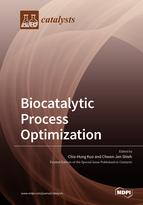Biocatalytic Process Optimization
A special issue of Catalysts (ISSN 2073-4344). This special issue belongs to the section "Biocatalysis".
Deadline for manuscript submissions: closed (30 June 2020) | Viewed by 62488
Special Issue Editors
Interests: food analysis, food processing, cellulase; lipase esterification and trans esterification; amylase; enzymatic kinetics; ultrasound-assisted enzymatic reaction; enzyme extraction; biotransformation; saccharification; response surface methodology; artificial neural network; wine fermentation
Special Issues, Collections and Topics in MDPI journals
Interests: biodiesel; lipid biocatalysis; enzyme technology; bioprocess optimization; supercritical fluid technology; Chinese herb medicine biotechnology
Special Issues, Collections and Topics in MDPI journals
Special Issue Information
Dear Colleagues,
Biocatalysis is very appealing to industry because it allows, in principle, the synthesis of products not accessible by chemical synthesis. Enzymes are very effective and precise biocatalysts as they are enantioselective, with mild reaction conditions and green chemistry. Biocatalysis is currently widely used in the pharmaceutical industry, food industry, cosmetic industry, and textile industry. This includes enzyme production, biocatalytic process development, biotransformation, enzyme engineering, immobilization, and recycling of biocatalysts. One of the most challenging problems in biocatalysis applications is process optimization. Experimental design combined with response surface methodology or artificial neural network are powerful tools for process optimization.
This Special Issue aims to cover recent progress and advances in the field of biocatalysis optimization using any methods, such as experimental design, response surface methodology or artificial neural networks. Other methodologies, even as one-factor-at-a-time experiments for optimization related to biocatalysis, are also welcome. We welcome both original research and review articles focused on optimizing the enzymatic process.
Assoc. Prof. Dr. Chia-Hung Kuo
Prof. Dr. Chwen-Jen Shieh
Guest Editors
Manuscript Submission Information
Manuscripts should be submitted online at www.mdpi.com by registering and logging in to this website. Once you are registered, click here to go to the submission form. Manuscripts can be submitted until the deadline. All submissions that pass pre-check are peer-reviewed. Accepted papers will be published continuously in the journal (as soon as accepted) and will be listed together on the special issue website. Research articles, review articles as well as short communications are invited. For planned papers, a title and short abstract (about 100 words) can be sent to the Editorial Office for announcement on this website.
Submitted manuscripts should not have been published previously, nor be under consideration for publication elsewhere (except conference proceedings papers). All manuscripts are thoroughly refereed through a single-blind peer-review process. A guide for authors and other relevant information for submission of manuscripts is available on the Instructions for Authors page. Catalysts is an international peer-reviewed open access monthly journal published by MDPI.
Please visit the Instructions for Authors page before submitting a manuscript. The Article Processing Charge (APC) for publication in this open access journal is 2700 CHF (Swiss Francs). Submitted papers should be well formatted and use good English. Authors may use MDPI's English editing service prior to publication or during author revisions.
Keywords
- enzyme
- biocatalysis
- optimization
- lipase
- cellulase
- protease
- enzyme immobilization
- glucosidase
- biotransformation
- enzymatic kinetics
- ultrasound-assisted enzymatic reaction
- enzyme extraction
- experimental design
- response surface methodology (RSM)
- artificial neural network (ANN)







